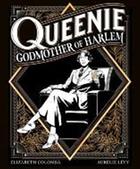
Duke Ellington, W.E.B. Du Bois, Dutch Schultz, Lucky Luciano: perhaps because they were men, their legacies have long survived their deaths. Too often missing from this notable New York roster is Stephanie St. Clair, a Harlem legend who ran the numbers racket in the 1930s. Aurélie Lévy and Elizabeth Colomba reclaim her history in Queenie, an outstanding graphic collaboration. In 1933 when Prohibition finally ended, St. Clair emerged from prison (not her first stint, nor her last) and returned to her posh apartment and Harlem society. In addition to restoring her illegal money-making empire, she also looked out for her fellow Black citizens--making loans and ensuring justice when due, especially when a little girl was involved. When St. Clair herself was young a quarter century earlier in Martinique, she learned far too early about vicious abuses by the wealthy. Her mother's death and her determination for a different life eventually led her to Harlem, where a trusted few people kept her safe as she expanded her influence.
Colomba, who shares St. Clair's Martinique heritage, is a lauded artist known especially for her visual reclamations of Black women in historic settings. She applies that energy--and stunning art--to sweeping, black-and-white panels. Together with French writer and filmmaker Aurélie Lévy, Colomba firmly places St. Clair--a ruthless businesswoman (but surprisingly caring human)--center stage. Lévy and Colomba effortlessly toggle St. Clair's narrative between the 1930s and her tumultuous coming-of-age decades earlier. Misogyny and racism are never far away, but St. Clair survives and thrives with unnerving control and lasting power. --Terry Hong, BookDragon

